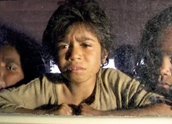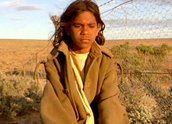


Rabbit-Proof Fence (2002)
Synopsis
In Western Australia in 1931, three mixed-race Aboriginal children are forcibly abducted from their mothers at Jigalong, in the eastern Pilbara. Molly Craig (Everlyn Sampi), 14, her sister Daisy (Tianna Sansbury), eight, and their cousin Gracie (Laura Monaghan), about 10, are taken at the orders of Mr AO Neville (Kenneth Branagh), the Protector of Aborigines, to the camp at Moore River, an institution for mixed-race children. They are scrubbed down and placed in a dormitory full of other Aboriginal girls, to be educated and trained as domestic servants.
After a few days Molly leads the other two girls in an escape. They are pursued by Moodoo (David Gulpilil), the institution’s expert Aboriginal tracker, but Molly knows how to disappear. They walk east, with help from strangers, both black and white, until they reach the rabbit-proof fence, the world’s longest fence. Molly realises this will lead them back to Jigalong. Pursued by State police and an increasingly sympathetic Moodoo, the girls walk almost 2,400 kms in nine weeks. Gracie is captured at Meekatharra, after she tries to catch a train. Molly and Daisy collapse on the saltpans, just before Jigalong. When they wake, the spirit bird, an eagle, is flying overhead. The two girls run to where their mother Maude (Ningali Lawford) has been awaiting their safe return.
Curator’s notes
Rabbit-Proof Fence is more than a significant film in the history of Australian cinema; it’s a significant landmark in the ongoing process of reconciliation between black and white Australians. For many white Australians, it was the first direct emotional experience of what it meant to be a 'stolen child’, and part of the 'stolen generations’. That identification with a history that was already contested made the film controversial. It was a popular success at the box-office, one of only a very few films concerning Aboriginal life that has ever been popular, but it remains very unpopular with some conservative politicians and commentators.
Conservative journalists and historians, such as Andrew Bolt and Keith Windschuttle, published articles charging that the film did not accurately reflect either the policies on removal of Aboriginal children of the time, or the circumstances of Molly Craig’s story, as recounted in the book on which the film is based, Follow the Rabbit-Proof Fence by Doris Pilkington Garimara, Molly Craig’s daughter. These claims were responded to by many, including historian Robert Manne, who accused Bolt of historical denialism, and the film’s scriptwriter, Christine Olsen, who published a detailed response to Bolt’s claims of inaccuracy.
In 2002 when the film came out, there were some criticisms of the film as being too soft, and too sympathetic to the character of AO Neville. Others claimed he had been defamed. The debate about the film’s accuracy and worth continues still, several years later.
What’s less controversial is the fact that it’s an extraordinary piece of storytelling by Phillip Noyce and his team. It was his first film on Australian soil after 13 years in Hollywood, during which he became highly successful. It was not his first film on an Aboriginal theme. One of the main reasons that Christine Olsen took her script to him was because she liked his 1977 film Backroads.
Noyce’s approach to the script of Rabbit-Proof Fence is unashamedly emotional. He has said he wanted to make a film in which every Australian viewer would become so emotionally involved that they would want to adopt the three girls as their own children. Most Australians have never read the Bringing Them Home report, nor personally met a 'stolen child’. Within a few years of its coming out, an enormous number of Australians had seen this movie – far more than had watched any previous Australian film dealing with an Aboriginal issue. It won best film at the 2002 AFI Awards, and the audience award at numerous international film festivals.
Rabbit-Proof Fence was released in Australia in 2002 and as well as being a box office success in Australia, sold to numerous overseas markets, achieving cinema distribution in key territories including the US, UK, France, Germany, Italy, Spain and Japan.
Secondary curator’s notes
by Romaine MoretonWhile the film shows the first time the girls were stolen from their families, it does not show the second time, when Molly – who eventually married and had two daughters of her own – was once again stolen. Molly and her two daughters, Doris and Annabelle, were taken to Moore River Native Settlement but when Molly escaped, she could only carry Annabelle, and had to leave the infant Doris behind. The real-life Molly was upset that the film did not show how they were forcibly removed a second time. When Doris was finally reunited with her mother Molly at the age of 25, she was given an Aboriginal name Nugi Garimara. Molly and Daisy would never see their cousin Gracie again.
The world premiere of Rabbit-Proof Fence was held in an outdoor screening at Jigalong, the outback community from which the girls were stolen and where, as grown women, they were living at the time of the premiere. This film has become important in introducing people to the concept of the 'stolen generations’, an era spanning from 1901 to 1970, when the government removed Aboriginal children from their parents if they were light skinned, or had any white blood.
Phillip Noyce is an established Australian filmmaker who is internationally acclaimed. His work includes such titles as The Quiet American (2002) and The Bone Collector (1999).
- Overview
- Curator’s notes
- Video 3 clips

- Principal credits
- Find a copy
- Make a comment
- Map
- Add your review




